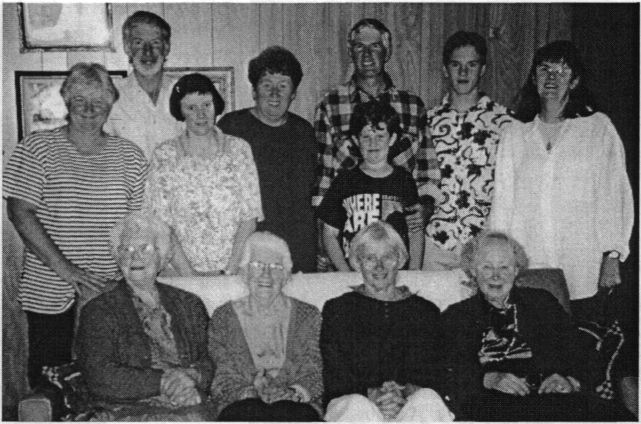

The Folk from the Wind Wound Isle > Chapter 21 : The Descendants of Agnes Robertson McCue
page 129
Introduction
The following chapters deal with the great grandchildren and great great grandchildren of Margaret Henderson and Arthur Robertson - generations ‘D’ and ‘E’ on the charts. Again I have divided the potted biographies according to the individual's descent from Agnes, James, Arthur Jnr, Margaret Jnr, Robert or William Adie.
Over the years the family has spread out and contacts have weakened or been lost. This has made it harder for me to collect information about people and understandably there are some who have little interest in their now distant Robertson connection. The result is a patchwork of stories and biographies and there are many gaps.
Twenty years separated the birth of Margaret Henderson’s eldest and youngest children, Agnes was born in 1838 and William Adie in 1858. With the next generation (‘C’), thirty years separates the eldest and youngest members. James Robertson’s first child John George Halls Robertson was born in 1869 and William Adie’s youngest daughter Adie Agnes Robertson in 1899. Gradually the spread of the generations has widened and by the time we get to generation ‘D’, there is a space of forty-two years between the first and last born, Samuel Arthur Crouch in 1899 and Jocelyn Christina Tunks in 1941. The first member of generation ‘E’ is Agnes’ great grand daughter Betty Ribbons, who was born in 1924. The overlapping of generations means we have people in one generation who are contemporaries of people in the next generation. For this reason I have included generations ‘D’ and ‘E’ in each of Chapters 21 and 22. Chapters 23, 24, 25 and 26 only contain generation ‘D’.

Turriff store where several Robertson relations worked
Listening to the stories people have told me it seems the lives of this section of the Robertson family was centred around Turriff in the Victorian Mallee during the 1930s and 40s. There isn’t much there now. A town you pass through barely noticing its existence. Once it was a thriving community with post office, store, school and churches. At Turriff, people were able to get work and Gertie Grace was able to undertake the tuition she needed to gain her diploma from the London College of Music.
page 130
As married women the McCue sisters Barbara, Bean and Aggie, all lived at Turriff. Barbara and Bean had houses next to each other and Aggie lived across the road. Ken Crouch tells us they were referred to as ‘The Big Three’.
This description of a typical concert at Turriff comes from Alan Ribbons:
“Aggie Mott would sing ‘My Grandfather’s Clock’. Rheita Mott played her autoharp and sang ‘I Threw a Kiss in the Ocean’. Rheita and Gertie would play a piano duet, and Ruth and Dorothy Grace sang ‘Don’t Fence Me In’. Beverley Grace sang ‘Bimbo bimbo’. Betty and Nancy Ribbons would dance an Irish jig. George Le Couteur always sang The Old Rugged Cross’ and his wife Arvon, sang ‘Mother McCree’. The items would vary from concert to concert, except that George could always be relied on to sing ‘The Old Rugged Cross’. Money raised from the concerts went to the hospital at Ouyen.” 1

Turriff Memorial Hall
The harsh climatic conditions made farming difficult. Drought and dust storms are recurring themes in the stories I have been told about life in the Mallee. Alan Ribbons describes how his father, who worked for the railways, would have to get up at night, phone the gangers and go out to shovel sand off the railway line so the train from Melbourne could get through to Mildura. Sand chutes were used to try and deflect the sand. Posts were placed in the ground to support sheets of iron that were supposed to ‘shoot’ the sand over the line. 2
Rabbits were a constant problem for farmers but at least they provided food and additional income during the Depression. This ‘Rabbit Poem’ comes from Alan Ribbons. 3The author is unknown.
There were rabbits hot and there were rabbits cold
There were rabbits young and there were rabbits old
There were fat rabbits and there were lean rabbits
There were dirty rabbits and there were clean rabbits
There were big rabbits and there were small rabbits
There were short rabbits and there were tall rabbits
There were black rabbits and there were white rabbits
Rabbits for breakfast rabbits for tea
Rabbits stewed and rabbit roast
Rabbits in gravy and rabbits on toast
Rabbits by the dozen rabbits by the score
Rabbits by the hundreds and still more and more
Rabbit’s tender rabbits tough
When the minister was asked to say grace he said
Lord spare me from rabbits I’ve had more than enough
Another rabbit story comes from Bessie Crouch:
“Dad [her husband Willie Crouch] used to trap rabbits and we had ferrets too. We often went round the traps at night with the lantern and if there were rabbits in them, Dad would reset them and he often got two in a trap for the night. When we had a good number of skins, we would take them into Terang and sell them. If they were a good price we would have a decent meal but if the price was low we had a pie, which were 3d [pence] or 3 cents. 4
page 131
“Ribbons had bought a place about a mile or so from us and we used to have some good fun together. One day Auntie Ellie came over and as Dad was sick she and I decided we would take the ferrets in a box and go rabbiting. We caught sixteen rabbits but we weren’t game to kill them so we carried them home alive in a bag. They were grunting like little pigs on the way and we could hardly walk for laughing.”
Generation D
Samuel Arthur CROUCH (1899-1985)
Eldest child of Barbara McCue and Edwin Crouch, born at Berriwillock on 26 January 1899. Known as Arthur. 5
Arthur trained as a Church of Christ minister at the ‘College of the Bible’ in Melbourne. Part of his training involved preaching in various local churches and this is how he met his future wife, Florence SCHULZ (1911-1982). Florence was the organist at the Bayswater church. The young couple fell in love, but there were two reasons for putting their marriage on hold. Firstly, Florence did not wish to marry until she was twenty-one, and secondly Arthur had dreams of preaching in the United States of America.
Arthur sailed to America (1930?) to attend an International Convention of Churches of Christ in Washington DC. 6 At the convention he met a friend from the Bible College who was already established in the USA and he had connections with churches in Missouri. As a result Arthur became a circuit preacher for five of these churches. Once he was established in Missouri, Arthur sent Florence an engagement ring and the fare for the trip to America. She sailed on the ‘Mariposa’ leaving Australia on 14 October 1933. Arthur met her on her arrival in Los Angeles and after the legal wait of three days for a license they were married at the Church of Christ Tabernacle in Los Angeles on 7 November 1933, surrounded by a new group of Christian friends. The young couple then travelled to Missouri by bus. Their only child, Barbara Ruth, was born in 1935.
Arthur and Florence moved to Weston, not far from Kansas city. However the cold weather was not good for Florence, so they moved on to Apache in Oklahoma where they served for sixteen years. Other ministries include Brownville and El Compo in Texas, Marlow in Oklahoma, Sulphur in Louisiana and lastly in Allerton, Illinois.
Barbara Ruth relates the following story:
“One morning when we were living in El Campo, [when] I was about twelve years of age, a couple came to my Dad’s office and asked to be married. They did not want to be married in the church, but wanted a minister to marry them. All their papers were in order, so Dad agreed, told them to come back to the house in an hour, and he would perform the ceremony. He walked over to the house and told Mother what had happened. At that time, renovations were being made on the bathroom in the house, and among all the tools and materials, the commode was sitting in front of the sofa. Mother expressed her surprise at the news, began to laugh, and said, ‘Well, we’d better get busy and put this place in order.’
So we set aside the materials and put a ‘throw’ over the commode, she took some flowers from the bushes outside the house, and the house was clean and beautiful for the bride and bridegroom who never had an inkling of what had taken place.” 7
The community at Allerton made it possible for Arthur and Florence to visit Australia, where there was a reunion with Arthur’s mother and other family members. On their return to America the couple retired to Apache. Florence died there in 1982. For a time in 1984, Arthur lived with his daughter and her husband Martin Lies, in New York but finally decided to move to a Christian Retirement Centre in Jacksonville, Florida. Barbara and Martin were with him when he died there on New Year’s eve 1985. Arthur and Florence are both buried at Apache.
page 132
Elizabeth Ellen CROUCH (1901-1999) - married name RIBBONS
Second child and eldest daughter of Barbara McCue and Edwin Crouch, born on 1 March 1901 at Brim, Victoria. Known as Ellie.
Ellie married John Adrian RIBBONS (1894-1978) at Cowangie Methodist Church on 2 April 1922. The ceremony was performed by the Rev R Reid. Jack was the son of William Charles Ribbons and Esther Isobel Ryles of Pinnaroo, SA. Ellie and Jack had three children, Betty (1924), Nancy (1926) and Alan (1927).
Jack was a returned serviceman from the First World War. He bought a farm at Panitya after he came back from the war, but sold this and moved to Karawinna near Mildura. Alan Ribbons describes life there: “No rain, dust, dust and more dust, and [we] had to ride the pony home from school, the pony could see but not us. Three on the one pony, and when we got home Mum would have the kero lamps, also some candles on the table to see. Mum would also put old blankets on the window [to] keep the dust out - more like sand, then use the garden shovel to get the sand out of the kitchen again.” 8
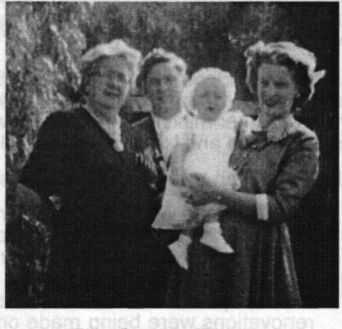
Ellie Crouch Ribbons With Alan, Nancy & Nancy’s daughter Rhonda 1949.
The family moved to a dairy farm at Laang, but there was no money so Jack worked on road building programs using his horses Doll, Ruby and Brownie. He made a living for the family but nothing extra, so the farm was sold and they moved back to dust and drought at Yarto East and another unsuccessful farming project. After this the family moved to Turriff where Jack worked on the railway line as a ganger and Ellie worked in the office ordering wheat trucks. Alan remembers Grandfather Ribbons staying with them when he was about twelve years old. Grandfather was an alcoholic and used to get the DTs. When his father was working away from home Alan would have to help his mother Ellie cope with Grandpa. As a result of this experience with his grandfather, Alan has never drunk alcohol. 9 Betty writes about her Ribbon’s grandfather, ”1 found him a gentle, kindly old fellow ... he was muchly appreciative of what we did for him later, when he was ‘dried out’ as it were.” 10
At Turriff Ellie’s parents and other members of her family lived close by. Ellie took in two boarders and accommodated the church ministers when they came around on circuit. She played the organ in the Baptist, Methodist and Anglican Churches. Betty tells us that despite the difficulties of life, the good times outweighed the unpleasant ones. She recalls gatherings at her Crouch grandparents’ house after church on a Sunday, for the evening meal. All the Aunts and Uncles would be there, “After we’d eaten we would gather around the old organ and sing the old hymns, and we all had a great time together.” 11
After the death of Edwin Crouch, Alan (who had moved to Sea Lake for work) and Jack shared the cost of buying Barbara Crouch’s house in Turriff and moving it to Sea Lake. Barbara lived there with Ellie and Jack (also Alan until he moved to Melbourne for work). Later Ellie and Jack lived in Geelong, where Jack died in 1978. Ellie then moved into a retirement village. She died just short of her ninety-eighth birthday.
Willie Robertson CROUCH (1903-1982) and Stephen CROUCH
Twin sons of Barbara McCue and Edwin Crouch born at Woomelang on 5 November 1903. Stephen died the same day he was born and is buried beside his father's sister, Ida Crouch, at Berriwillock, Vic. Willie was known as both Willie and Bill.
page 133
Willie had a struggling farm at Merrinee, “800 acres and had cleared 600 acres of it with an axe. The land had been opened up by the Closer Settlement Board who put houses on the places and provided some machinery and horses to work them after it was cleared. However the years were mostly dry then and it was hard to make a living.” 12 Willie also did butchering, delivering the meat to neighbours in a cart. In 1934 the Board reclaimed most of the farms, paying compensation. Willie received £60 for the eight years work he had put into the farm.
Alan Ribbons describes a visit from his Uncle Willie, “...you’d hear him coming for a couple of mile back down the road, he’d be singing at the top of his voice and yelling at the ponies - ‘G’deaar’up, g’deaar’up’, and he’d hit the creek, which was quite a bit of water, and the water would go ‘woosh’ everywhere, but he’d go straight through, never slowed up because there was a bit of water.” 13
Willie went shearing with his cousins George and Stuart Le Couteur. While he was staying at their parents place in Cowangie, Willie met Bessie LE COUTEUR (1914-2001). Bessie was Henry Le Couteur niece and she was visiting her uncle and his wife Bean. With money made from shearing, Willie bought an ‘Overland’ car and took Bessie to meet his parents at Merrinee. Bessie’s family lived at Nullawarre so Bill (as his wife refers to him) worked around that area for a time and then bought a small farm at Laang with the assistance of a bank loan. Like Ellie’s husband, Bill did road work to earn extra income, using a horse, a dray and a shovel.
Bessie and Bill became engaged on her twenty-first birthday and they were married four months later (March 1936) in her parents lounge room at Nullawarre. A Baptist Minister, the Rev Sam Watson, officiated and George Le Couteur was Willie’s best man. For their honeymoon the couple went on a camping holiday to Port Campbell. Bessie was the second child and eldest daughter of Archibald James Le Couteur and Florence Goldstraw. 14 Bill and Bessie had four children, Beth (1937), Clive (1940), Margaret (1943) and Lorraine (1946). Margaret died from meningitis at the age of two.
Bessie writes about life on the farm: “The kitchen wasn’t lined so we lined it with hessian and papered it with newspapers. ... Not many homes had bathrooms then and we had our baths in oval galvanized iron tubs. We also used them to wash the clothes in and white clothes and colour fast things would be boiled in coppers which were often outside. We had no copper at first so I boiled the clothes in a 4 gallon kerosene tin on the stove.” After about twelve months the farm was sold for a profit and the mortgage paid off. Bessie was expecting her first child so she and Norm moved into Warmambool where Bessie’s parents were now living.
After Beth’s birth Bill and Bessie moved back to the Mallee, living at Turriff. Bill worked at clearing the water channels in the winter and helping with the harvest and fruit picking in summer. “The channels were the water system to the Mallee and every year they would fill up with sand so the men would work with horses and big scoops to clear them out ready for the water to run. ... it was good money for those who worked on them.” 15
Deciding to get a house of their own, Bessie and Bill bought a block of land next to the Turriff hall and moved a house that cost them £50 from Patchewallock. While they were waiting for the house to be ready Bill worked at Speed helping to install new water pipes. This involved digging deep holes to find the old pipes. Bill and two others were working in a trench about two or two and a half metres deep when the trench caved in. His two mates managed to get clear but Bill was buried with only his head and one shoulder free. Bessie writes, “Dad said he never saw men work like they did to dig him out. ... I remember him driving home and casually saying ‘I got buried today’.”
At the time Bill’s injuries were not treated very seriously and he was soon back at work. However over a period of time he became more and more disabled with pain in his back and legs until he was no longer able to work. He was eventually diagnosed as having Spondylitis (a form of osteoarthritis). The couple now had two children and all their savings were gone. For a time they stayed with relations at Nullawarre and Grassmere. Bessie decided she had to get work and seeing an advertisement in the ‘Countryman’ paper she applied for and obtained work running a Post Office at Miram near Kaniva, starting in September 1942. While Bessie worked Bill looked after the children.
page 134
Bessie writes:
“It was a busy PO in those days as it was war time and I had to pay out military allotments to the wives of servicemen as well as child endowment and some pensions. I sometimes wonder how I did it as sometimes the phone would be ringing and the mail bags had to be got ready in time for the train and people coming in wanting things. I had to keep account of every phone call and write a docket for every trunk call. I had to do weekly and monthly balance sheets also order stamps and all the other things that were needed. ... I got £3 a week wages and we paid ten shillings a week rent, also kept ourselves and two children and saved a few shillings.”
Bessie left the Post Office when she was pregnant with Margaret and Bill was granted an Invalid Pension. They sold the house in Turriff to Bean Le Couteur for £140 and with the help of friends, the Church of Christ and the Department of Social Services, they built a house on a block of land at Kaniva given to them by Mr R M Williams. For the first time they had electricity. Bill supplemented their income by mending wheat bags but this income dried up when bulk handling came in. As well as making her own family’s clothes Bessie sewed for other people, which helped to supplement the pension.
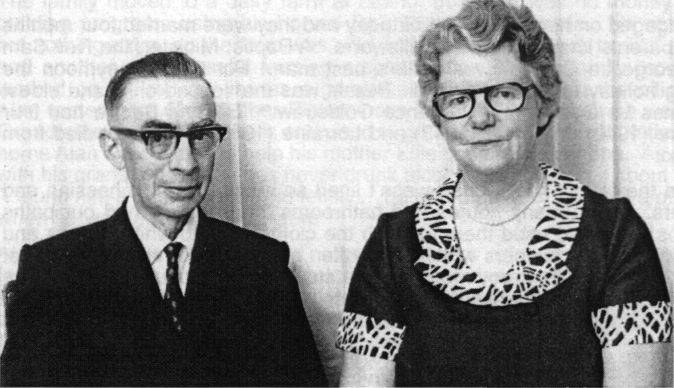
Willie Crouch and Bessie Le Couteur Crouch
Willie suffered from diabetes for the last twenty years of his life and died of stomach cancer in 1982. Bessie died at Kaniva in 2001. They are both buried at Kaniva. In ‘Family Writings’ there is a hymn Bessie wrote, which won first prize in a Church of Christ hymn writing competition.
A last story is about Willie Crouch and his mother. Mothers sometimes find it hard to get out of the role of being a mother and it seems Barbara Crouch was no exception.
Following the afternoon reception held to celebrate Barbara’s 100th birthday at Sea Lake in January 1971, the family was sitting out on the verandah in the evening heat. Willie, who was fast approaching seventy, looked at his watch and commented that it was ten o’clock already. ‘Yes Willie,’ responded Barbara, ‘time you were in bed, much too late for you to be up.’ 16
Edwin John CROUCH (1905-1966)
Fifth child and fourth son of Barbara McCue and Edwin Crouch born at Woomelang on 29 January 1905. Known as Eddie. 17
At the time of Eddie’s birth, his father was farming in the Woomelang district and working on the construction of the Melbourne to Mildura railway line. Ken Crouch tells us that when Michael McCue lived with Eddie’s parents at Panitya, Michael would take Eddie with him in the cart when he went to Pinnaroo to collect his pension from the Post Office. “Afterwards they adjourned to the pub where Michael ordered ‘a whiskey for me and a squash for the boy’. On the barman enquiring whether [Mick] wanted water with the whiskey, he was told in no uncertain terms ‘No, there is too much water in it already’.” Eddie was about twelve years old at the time and his job was to drive grandpa home again if he stayed too long in the pub.
page 135
As the Crouch family moved from one farm to the next, Eddie worked on the farm with his father. At one stage he worked for his Uncle Henry Mott at Gama and later he did seasonal work, fruit picking in the Red Cliffs area. He was friendly with his cousins Stuart and George Le Couteur. While fruit picking Eddie met Fred Finger, whose family were orchardists from Wantirna near Melbourne. Fred invited Eddie to visit and as a result he met Fred’s sister, Adah. Love blossomed and in 1935 Eddie married Adah FINGER 18 (1907-1991) at the Bayswater Church of Christ, Melbourne, in a service conducted by Pastor R Williams.
This was during the Depression and making a living was not easy. The couple moved to Mildura in search of work. Their first child was stillborn in 1936. Lindley (1938) and Ken (1940) were born in Mildura. Ken tells us, “transport there was bicycles, and while visiting friends in this manner, Eddie borrowed a baker’s bread basket to carry Lin in, perched on the handlebars of the bicycle”.
When Eddie joined the army in 1940 the family moved to Melbourne. Eddie’s army service was as a cook and his youngest son, Richard (born 1947), has his old recipe books which include items such as: ‘Stew for 100 men - take 451b meat, 601b potatoes, 201b onions, etc,’ and Treacle Pudding - 141b S R Flour, 41b dripping, 61b treacle, 11b crumbs, water to mix.’ After about a year Eddie was discharged from the army and he worked as a driver at a large flour mill. Next he worked in a produce store and after that for Trans Australia Airlines at Melbourne airport.
In 1953 Willie Crouch advised his brother of a farming opportunity at Kaniva and the Eddie Crouch family moved there, working a wheat and sheep farm on a share basis. In 1957 the family moved again, this time to Sea Lake where Eddie’s mother lived. His sisters Ellen and Barbara also lived there, the latter moving to Sea Lake with her family soon after Eddie’s family. This gathering of family provided a happy social life. At Sea Lake Eddie worked in the local store.
Eddie was a keen member of the Masonic Lodge both in Melbourne and Sea Lake. He had a fine voice and sang with both church and lodge choirs. Eddie died at Swan Hill after suffering a stroke, and is buried at Sea Lake. He was sixty-one years old. Adah survived him by twenty-five years.
Norman Percy Henderson CROUCH (1907-1968)
Sixth child and fifth son of Barbara McCue and Edwin Crouch, born at Woomelang on 22 August 1907.
Norm was married to Myrtle SELBY (1913-2001) at the Red Cliffs Church of Christ by Pastor Cameron on 4 April 1931. Their only child, Donald, was born the following year.
Bessie Crouch gives us this story about Norm and Myrtle. Willie Crouch and Norm decided they would go fruit picking near Swan Hill. “We took tents and camped close to the Murray River near where the job was. The men picked grapes and Myrtle and I decided we would too, so we asked for a job and took it in turns to pick - one in the morning and the other in the afternoon. Next day we would change over so one wasn’t picking in the heat of the afternoon all the time. The one not picking would look after Don and Beth [Bessie’s daughter].” 19
Norm was a horse breaker and trainer, and Ken Crouch tells us he still had horses in ‘the 1940s and 1950s when nearly everyone else had got rid of them in favour of cars and tractors’. Norm worked for the State Rivers and Water Supply, which ran the water channel system throughout the Mallee. The family lived at Speed and Norm was the ranger for the Turriff/Speed area.
Norm died in the Ouyen hospital at the age of sixty-one, following a stroke, and is buried at Woomelang. Donald had been running the bakery at Speed but after Norm’s death, he and his mother moved to Irymple. After Don died in 1977, Myrtle moved to Meningie in SA where she had relations living. She became blind in later life and lived in a nursing home in Meningie. Myrtle died in 2001.
page 136
Clive Oswald CROUCH (1913-1921) - twin with Barbara
The twins were the youngest of Barbara McCue and Edwin Crouch’s nine children. They were born at Panitya on 9 August 1913.
Barbara vividly recalls the death of her twin brother following a riding accident at the age of seven. The children took it in turn to bring in the cows for milking and on this afternoon it was Clive’s turn. Barbara was with her mother in the kitchen having her hair curled when there were shouts from the stable. The cart was got out and Clive was brought back to the house in this, suffering fatal head injuries. Clive had taken his pony down to the dam for a drink and as he went to remount, the horse was startled by a bird and shied. Clive was dragged with one foot in the stirrup. He survived unconscious for several days and then quietly died. ‘I could hear Mother pacing up and down in the kitchen at night, praying.’ After 80 years the pain of this event still brings tears to Barbara’s eyes and to the eyes of those listening to her as she told me the story when I visited her in April 2000.
The accident took place when the family was living at Cowangie and a pine tree was planted on the farm in Clive’s memory. Clive is buried at Murrayville.
Barbara Agnes Adie Erichsen CROUCH (1913-) - married name ROGERS
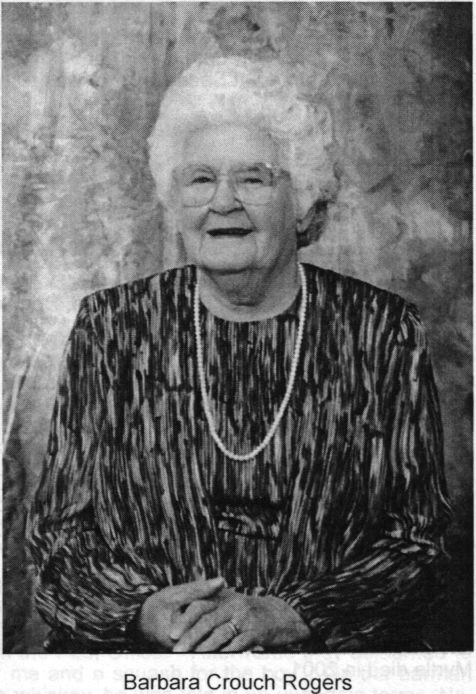
Barbara and her twin brother Clive were born at Panitya on 9 August 1913, the youngest children of Barbara McCue and Edwin Crouch. The name Barbara came from her mother, Agnes from her maternal grandmother, Adie after her great uncle William Adie, and Erichsen after Dr Erichsen who attended her birth. 20
Barbara attended various primary schools as her family moved around Victoria and South Australia, and gained her Merit Certificate. By then the family was living at Merrinee and the nearest high school, at Merbein, was 23 miles away. There were no buses in those days so Barbara undertook three years secondary schooling through the Correspondence School based in Melbourne, supervised by the head teacher at the local primary school. She worked as a temporary junior teacher at the Merrinee School, and later as sewing mistress. Barbara was twenty-one when her parents left Merrinee and she moved with them to Port Campbell. Moving again with her parents, this time to Turriff, she worked as bookkeeper in the general store.
In 1940 Barbara married Stan ROGERS (1912-1979) at the Turriff Methodist Church. The service was performed by Baptist minister Geoffrey Blackburn. Stan was a farmer. The couple had thirteen children born between 1941 and 1958. Two died at, or soon after birth. The eleven surviving children are Jennifer (1942), Bevan (1945), Barbara (1946), Arthur (1947), Heather (1950), Edwin (1951), Lyndon (1952), Lois (1953), Phillip (1954), Reta (1956) and Julianne (1958).
page 137
Stan had a lease at Merrinee North, and the couple farmed there for seventeen years. All the children except Julianne were born in Mildura. Barbara and Stan felt there was not much going for the young people at Merrinee, it was too isolated. There was a railway station, a shop cum post office, a public hall, some rural agencies and not much else, and the children had to go away to find work. So the Rogers decided to sell out at Merrinee North and bought a farm at Sea Lake, where they lived for the next seventeen years.

A Gathering of Agnes’ Descendants Portland, Victoria, April 2000
Left to right, back row: Janette and Clive Crouch, Raelene Powell, Anne, Laura and Arthur Rogers, Brendan Kiley, Barbara Francis,
Seated: Bessie Crouch, Barbara Rogers, Margaret Worrall, Betty Powell.
Barbara Crouch lived with Barbara and Stan Rogers until her death in 1976. Barbara’s sister Ellie Ribbons lived nearby and she helped with the care of Barbara senior. [There seems to be some confusion here as I have also been told Barbara Snr lived with Ellie and Jack Ribbons. Perhaps she moved back and forth between the two families], Stan died three years after Barbara Crouch, leaving Barbara Rogers and her youngest daughter Julianne on their own in the big house. Julianne then left home to study hairdressing. Another daughter, Barbara Francis, was moving with her family to Portland on the south coast, and invited Barbara to come and live with them. Barbara Rogers continues to live with the Francis family in Portland. In October 2002 there was a family gathering of Rogers in Sea Lake with over eighty family members attending.
Agnes Elma Emily Le COUTEUR (1904-1964) - married name COX
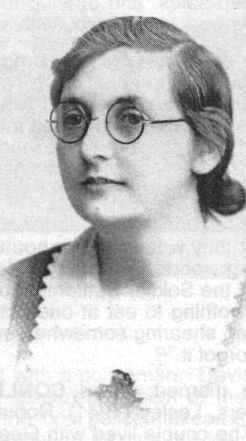
Elma Le Couteur Cox
Eldest child and only daughter of Robina McCue and Henry Le Couteur, born at Allansford on 10 July 1907. Always known by her second name.
Elma married Arthur COX (1902-1957) at Cowangie, Victoria in 1927 and they had two daughters, Mareon (1927) and Myra (1930) and one son, Harry (1932).
Arthur died in 1957 of cancer and is buried at Bendigo, Victoria. Elma died of heart disease seven years later and is also buried at Bendigo.
page 138
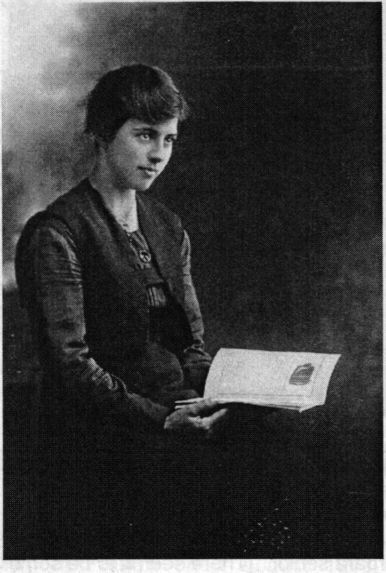
Elma Le Couteur
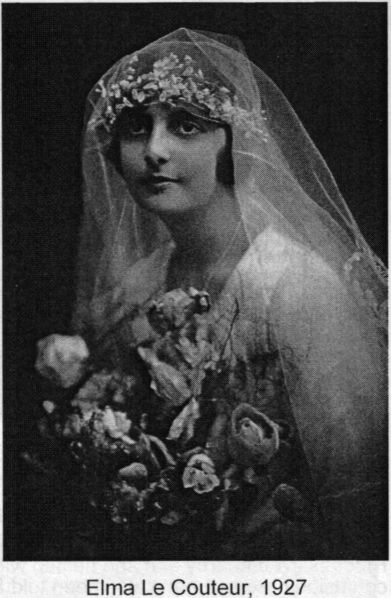
Leslie George Le COUTEUR (1905-1991)
Eldest son and second child of Robina McCue and Henry Le Couteur, born at Allansford on 22 May 1905. Always known by his second name.
George had a variety of jobs including shearer, drover, and wheat lumper at Turriff. For a time he worked as a labourer building the Great Ocean Road and at another stage he worked for the Lands Department. He broke horses, trained dogs and raised greyhounds. He even had a go at farming. George started his droving career by staying away from school, hanging around the sheep sales, and offering to drive the sheep out to a farmer’s property for him. His early shearing work was shared with his brother Stuart.
George drank heavily but I am told, ‘you wouldn’t know he was drunk when he sang’. At one stage George and his family lived in a house next to his aunt Barbara Crouch at Turriff. The walls of the shed were lined with beer bottles and when he moved out, Barbara got chaff bags from the horse yards, packed the bottles into them and dragged them down to the railway yard. Here there was a deep hole made by excavations for the railway line, and into the hole went the bags of bottles. Barbara then got the axe and smashed the bottles, stating categorically, 'no one will ever use these again’. 21
Despite his drinking, his teetotal Auntie Barbara was very fond of George and when he went to visit her they would talk for hours. After Edwin died, George would do jobs for Barbara such as chopping wood. Barbara told Ken Crouch that George had ‘nearly saved their lives’ when they were on the Soldier Settlement block at Merrinee during the hard times of the 1930s. “They had almost nothing to eat at one stage and George came through in a gig, heading home after he had been shearing somewhere, and he had a side of lamb and a bag of flour for grandma. She never forgot it.” 22
George married Arvon CONLIN (1918-1986) at Eaglehawk in 1940 and they had three daughters, Lesley (1941), Robina (1944) and Heather (1949). George always called his wife Con. The couple lived with George’s mother in Bean’s big old house and Bean needed lots of attention because of her asthma. She liked to be waited on and would call out to Arvon at 2 o’clock in the morning, wanting a cup of tea and ‘a thin slice of bread and butter please’. Arvon
page 139
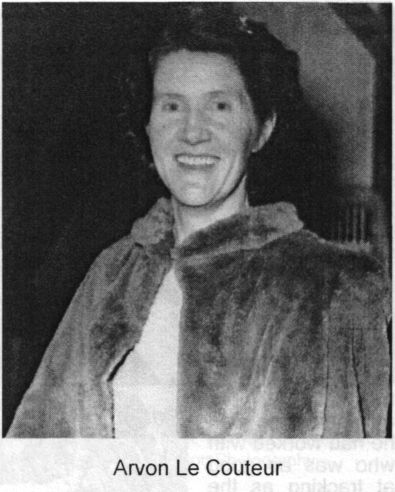
would have to get up and light the wood stove to boil the kettle. Looking after Bean, George and her children, as well as the agencies she ran, Arvon was always busy. She has been described to me as a remarkably placid person, who never complained. However, she instructed her daughter Heather, ‘When I get old and can’t look after m’self any more, whatever you do, don’t ever bring me to live with you.’
Despite her busy life Arvon managed to be ‘the best hostess around’. She and George had agencies for wheat and oats, which were run from the big kitchen under the house. In the summer Arvon was flat out answering phone calls and taking orders, and the large table would be covered in stuff, ‘Anyone who came in the door, it was - Have a cup of tea - Righto! - We’ll just move a bit of stuff. Things would be pushed around and a tiny corner cleared and cups laid out. Dorothy Geary says she and her mother, Gertie Grace, used to tidy things up, but next time they came around the table would be just as cluttered and a tiny space would again have to be cleared for the tea cups. 23
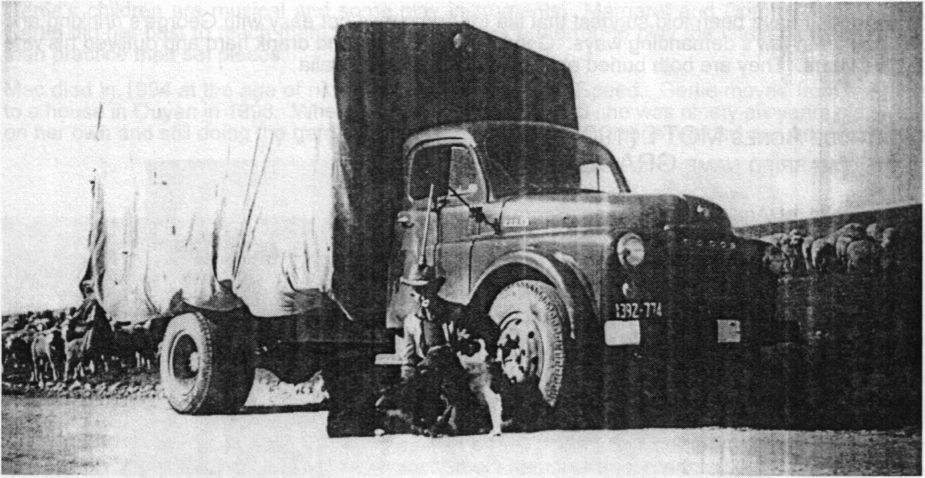
George Le Couteur With kind permission of Waikerie River News’.
George’s daughter, Heather, provided me with a copy of an oral history tape made by George in 1985 and an article published in the Waikerie newspaper on 11 September 1985. These record George’s memories of droving, in particular the last big drive of 3000 sheep from Hawker in the Flinders Ranges of South Australia, to Pinnaroo, near the border of Victoria, in the early 1960s. This took three and a half months and involved taking the sheep across the Murray River on the ferry at Waikerie.
In the newspaper article George tells of a confrontation he had with a policeman. David Mott, who is the son of George’s cousin Russell Mott, tells a less sanitized version of the same story. 24 Seems George was in the Hopetoun pub drinking when the local policeman came in and asked George if he was responsible for the sheep that were wandering all over the town. The policeman told George that if he did not move the sheep on he would arrest them. George’s
page140
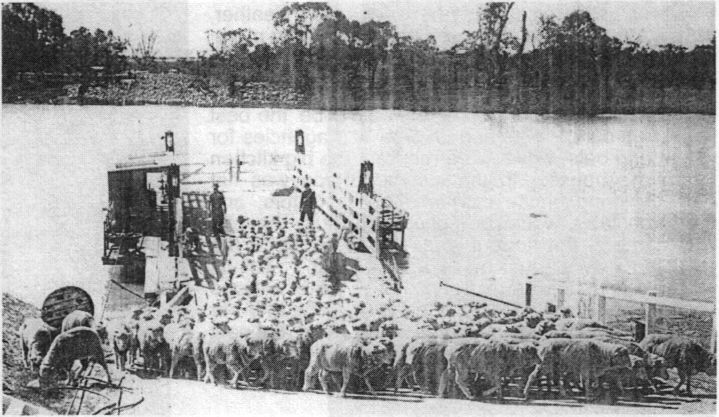
George Le Couteur’s last big sheep drive.
Taking sheep across the Murray on the punt at Waikerie in the 1960s. With the kind permission of Waikerie ‘River News’.
response was to say to his mate, “Okay, pack up the cyclone we’re going home for the weekend.” He then reminded the policeman that if he arrested the sheep they would be his responsibility and he would have to see they were yarded, fed and watered. He had no further trouble with the policeman.
David Mott tells another story about George Le Couteur. When passing through Adelaide Airport David got talking to a retired policeman who had written a book about his experiences with black trackers. The ex-policeman said that there had been only one white man he had worked with who was as good at tracking as the Aborigines. Having a copy of his book with him he pointed out a photo of this man to David. It was George Le Couteur. The policeman said George was the funniest man he had ever worked with, but very clever.
The stories I have been told suggest that life for Arvon was not easy with George’s drinking and her mother-in-law’s demanding ways. George worked hard and drank hard and outlived his wife by five years. They are both buried at Waikerie in South Australia.
Gertrude Agnes MOTT (1904-) - married name GRACE

Gertrude Mott - the music graduate
Eldest child of Agnes McCue and Henry John Mott, born at Warracknabeal, on 3 August 1904. Generally known as Gertie.
When the family moved to Gama East, Gertie’s father did not consider her old enough to drive the horse and cart to the Turriff School, so she missed out on a formal school until she was eleven. Her first schooling was with a Mrs Harrett who lived on a property some miles from the Mott farm and Gertie and her sister, Rheita, used to walk there for their lessons. Later they went to school in Turriff. After leaving school, Gertie worked on the farm. In 1922 at the age of eighteen Gertie took out her Diploma of Music from the London College of Music for pianoforte playing. In 1923 she became an Associate of the LCM and in 1926 a Licentiate. Gertie was able to attend lectures and do her music exams in Woomelang and Turriff. She taught music for six years before her marriage. Despite arthritis in her hands Gertie played the piano for me when I visited her in April 2000. I was able to observe that she has the large square hands that are common amongst Robertson descendants.
page 141
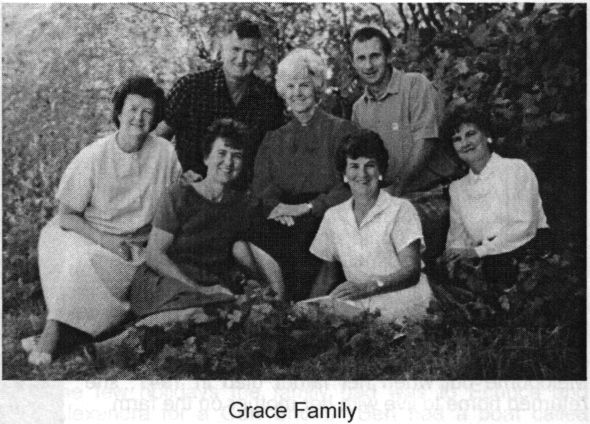
Left to right, back: Dot, Austin, Ruth, Ron; front: Bev, Verna, Margaret.
With the kind permission ofTonyRawson Photography.
In 1929 Gertie married John (Mac) McCarthy GRACE (1903-1994) at the Gama East Baptist church. Mac was born at Traralgon in Victoria. Gertie and Mac had seven children, five girls and two boys, Ruth (1930), Dorothy (1931), Margaret (1934), Verna (1936), Austin (1938), Beverley (1942) and Ron (1944).
Mac and Gertie were pioneer farmers at Turriff West, on land selected there in 1927. The property is called ‘Carinya’ and in 1977 won the Hanslow Cup for farm management, productivity, improvement and environmental management. An irony is that having cleared the trees to establish the farm, trees are now being replanted as part of the environmental management program. Austin took over the farm from his parents, and it is now run by grandson Michael and his wife Julie.
Gertie played the church organ for over seventy years, mostly at the Turriff Baptist church. The Church presented her with a plaque to commemorate this remarkable effort. In 1988 she received the local Australia Day award as 'Neighbour of the Neighbourhood’. Gertie is very modest about her achievements and most of the information I have about her has comes from her children and grandchildren, rather than from Gertie.
Gertie’s children are musical and some play instruments. Margaret and Dorothy told me that Gertie did her best to teach them the piano but they preferred to play the latest hit tunes rather than practice their set pieces.
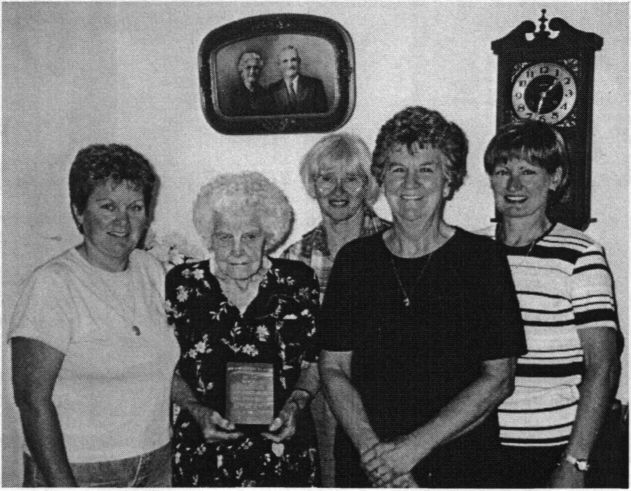
Gathering at Gertie’s house in Ouyen, April 2000 Left to right: Colleen Barnes, Gertie Grace, Margaret Worrall, Verna Monaghan, Marita Miller. Gertie is holding her citation as Neighbour of the Neighbourhood 1988’. Note the photo on the wall of Gertie’s parents Aggie & Henry Mott.
Mac died in 1994 at the age of ninety-two, and is buried at Speed. Gertie moved from the farm to a house in Ouyen in 1998. When I visited her in April 2000 she was ninety-six years old, living on her own and still doing the gardening and most of the other things needed around a house.
page 142
Rheita Mary MOTT (1906-1977) - married name MITCHELL
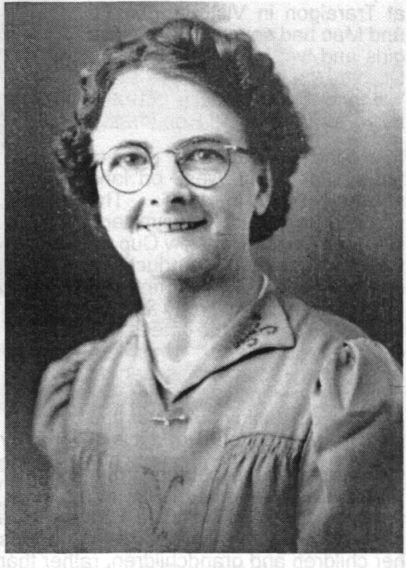
Rheita Mott
Second child and second daughter of Agnes McCue and Henry John Mott, born at Warracknabeal on 25 May 1906.
Rheita grew up on the family farm at Gama East. Her early schooling was under the direction of a neighbour, Mrs Harrett. Later she attended the school in Turriff. Aggie encouraged her children’s musical ability and Rheita was given an autoharp. This is now in the custody of Rheita’s niece, Margaret Powell (nee Grace).
Rheita suffered from a ‘weak heart’. She worked for a time as a domestic at the Baptist College in Melbourne but when her father died in 1947, she returned home to live with her mother on the farm.
On 27 August 1949, Rheita married Albert MITCHELL (1916- ) at the Bendigo Baptist Church. After honeymooning at Daylesford the couple made their home at ‘Westleigh’ in Speed, farming wheat and sheep. Land had to be cleared and dams made, and Bert also did outside work clearing local irrigation channels.

Rheita Mott’s Wedding to Bert Mitchell, 27 August 1949
The three bridesmaids are Ruth, Margaret & Beverly Grace. Gertie & Mac Grace are left and right in the back row.
Agnes McCue Mott is in front with the handbag
Rheita and Bert adopted three children. The three were siblings, with the same natural parents, Sue (1947), Ken (1949) and Paul (1954). Ken was killed in an automobile accident in 1968.
page 143
Rheita held strong Christian beliefs. She played the organ for church services at the Baptist church in Turriff and the Methodist Church in Speed, and participated in the Lady’s Guilds. Sue remembers Rheita and Grandma Aggie doing the week’s washing together with a wringer washing machine, ‘Mum on one side, Grandma on the other. Mum always cleaned the house on Saturday, washed the floors and kitchen louvre windows and Mum nearly always cooked a leg of mutton Saturday for a cold Sunday lunch - if cold in winter we might get soup and hot potatoes with it. Most Sundays a custard was made for dinner - no work was done on Sundays.
I remember Saturday nights in winter making toast in front of the stove for scrambled eggs and soup, while watching the footy replay. Mum made good powder puffs filled with cream.’ 25
Bert enjoyed tennis and clay shooting and one of the few holidays the family had was to Echuca and Alexandra for a Gun Shoot. Bert had a boat called ‘Whirl Wind’ and the family would go to the lakes for boat trips and water skiing.
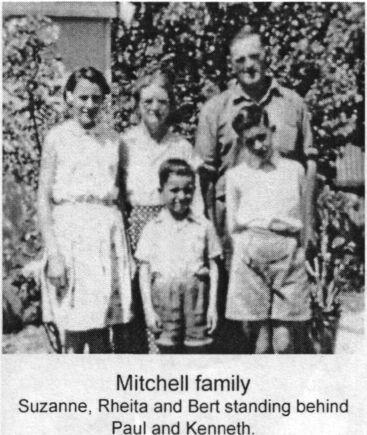
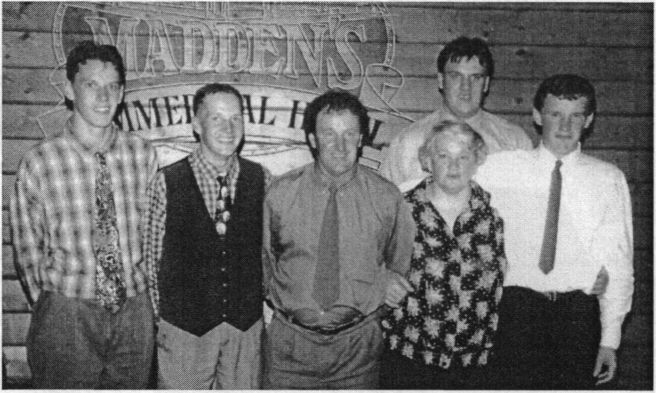
Sue Mitchell Boyd
With her husband Brian and sons Rodney, Mark, Stuart and Craig.
Aggie lived with the family in later life but eventually Rheita was unable to look after her because of her own ill-health, so Aggie went to live with Gertie. Rheita died at Hopetoun on 7 May 1977 and is buried at Speed.
Bert remarried in 1985. His second wife, Melva Nesvold (nee Vivian), was a widow whose husband had died six or seven years earlier. Melva died on 24 December, 1999. After Melva's death Bert moved to ‘Lovely Banks’ nursing home in Cobden.
Russell Edgar MOTT (1910-1999)
Fourth child and second son of Agnes McCue and Henry John Mott, born at Gama East, Victoria on 7 August 1911.
While on holidays at Lome on the south coast of Victoria, Russell met Vivienne HOWE (1911-2002) whose family ran a Post Office near Colac. The couple were married at Redcliffe in 1937 and had six children including two sets of twins, Graham (1938), Jeffrey and David (1939), Marie and Doreen (1941) and Bruce (1945).
Russell worked on the family farm. This comprised a number of blocks and when Henry Mott died in 1947 he left a block to Gertie, a block to Rheita and several blocks to Russell. Russell continued on the farm eventually buying his sister’s blocks and adding more land, which he purchased off surrounding farmers.
Russell was very fond of dogs. At one time he had twenty-two of them. Everyone in the district knew Russell and his dogs. They would see him coming and know it was Russell because he drove so slowly and the back of the Ute would be full of junk. His dog would be draped behind
page 144
George across the back of the seat, its head out the window. Russell’s last two dogs were Girlie and Sandy. Granddaughter Debbie Riley who lived with her grandparents after she left high school remembers Russell with great affection. Debbie fondly claims, “Sometimes Girlie and Sandy got more affection than Grandma, more than anyone else in the family.” 26 Russell insisted on a substantial cooked breakfast and had his own special cup and cutlery, making a fuss if they were not on the table for him. Debbie says Russell was “a real worry wart”, but he had a great sense of humour and told wonderful stories. His rare letters to Debbie were gems full of news about family and friends. One of his ‘party tricks’ was to light a match and burn the hairs out of his ears.
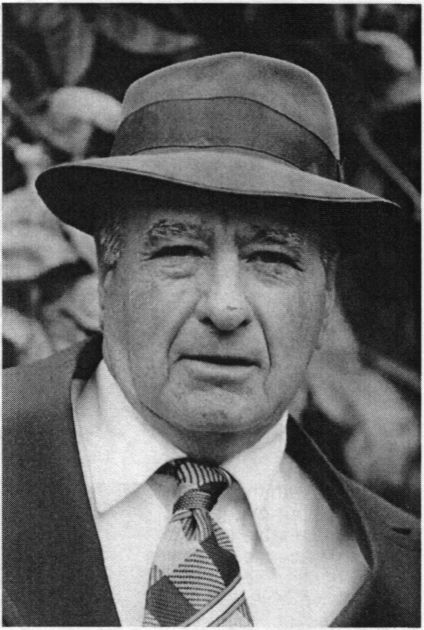
Russell Mott
Farming was Russell’s life and he was reluctant to retire. Eventually he and Vivienne moved to Sea Lake, but he was still driving out to the farm when he was in his eighties. Bruce and his son Ashley now farm the property. Graham and his sons have properties in the same area.
Russell died in 1999 and is buried at Sea Lake. Severely debilitated Vivienne spent her last years in a nursing home and died at Sea Lake in 2002.
Marjorie Constance McCUE (1915-) - married name MATHIESON
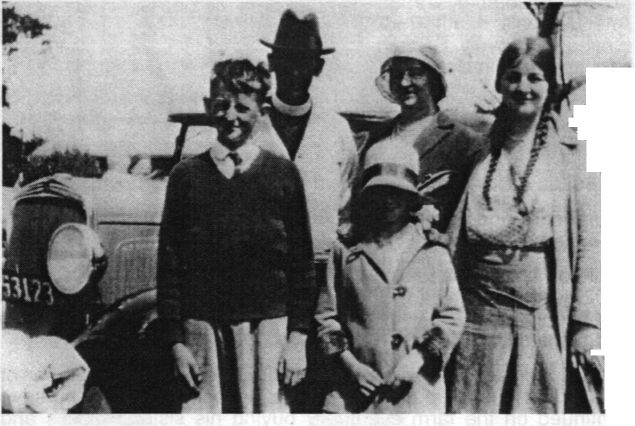
Jack McCue’s Family Left to right: John, Rev Jack, Marion, Tot and Majorie
First child and elder daughter of the Jack McCue and Edith Collins, born in Melbourne on 1 July 1915. 27
Marjorie left school at seventeen and trained as a nurse at the Eye and Ear Hospital in Melbourne. On completion of her training she worked for a Collins Street eye surgeon for four years. She studied chiropody at night but never practiced.
On 9 September 1938, Marjorie married Archibald George MATHIESON (1907-1960) at Canterbury, Victoria. Archie was the son of Archibald Mathieson and Annie Laura Le Couteur. 28 He was born on the family farm ‘Errawallun’
page 145
at Nullawarre. After their marriage Marjorie and Archie had a dairy farm ‘Moongana’ which was west of ‘Errawallun’. Although adjacent to other Mathieson properties, it was not part of the original farm. Archie and Marjorie claimed three local ‘firsts’ for their farm - the first post war car in the district (a 1948 Pontiac Silver Streak), the first refrigerated milk vat (about 1958), and the first to go with 100% artificial insemination (1960).
Marjorie and Archie have four children, Marie (1940), Evan (1943), Nola (1944)and Ross (1956), all born at Warrnambool. When Archie died from a heart attack at the age of fifty-three, Ross, the youngest child, was only four years old. Marie had already left home to study hairdressing. Marjorie and seventeen years old Evan continued running the farm for two years. Evan however wanted to do other things and at nineteen he went back to school to get his High School Certificate. Marjorie sold the farm in 1962.
Moving to Melbourne, Marjorie ran a boarding house at Armadale and then bought a house in Kew. These houses represent the first in a series of houses and businesses, which Marjorie bought, developed and later sold at a profit. She bought a hairdressing salon and this gave her income while she was renovating the houses. The three eldest children had a second salon between them, Marie drew a salary and the profits were shared. Marjorie tells us she “also knitted madly. Did twenty five jumpers one year and sold a pair of random coloured overalls to actress Phyllis Diller when she was in Australia.”
Marjorie bought a Rambler V8 and she and Ross travelled to Queensland where they lived for nine years. Here again Marjorie bought houses and land, developed them and then sold them. Renovating houses was something she enjoyed. Evan also moved to Queensland and Marjorie helped him set up in a furniture business. Nola returned to the Western District and married there in 1967.
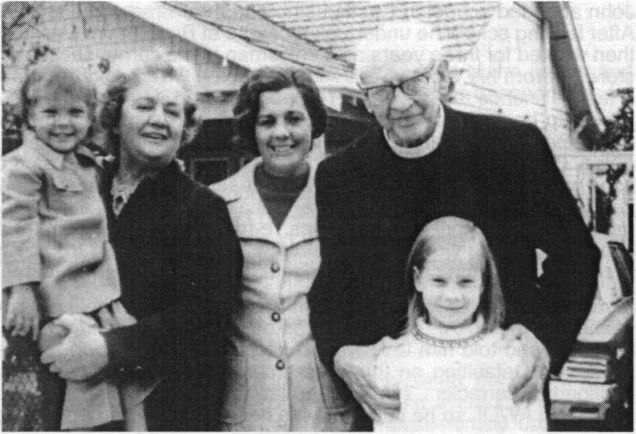
Four Generations of McCues Left to right: Sheridan Keys, Majorie Mathieson, Marie Keys, Jack McCue, Wendy Keys
Marjorie returned to Victoria because her mother was ill and moved in with her parents. After Tot died in 1971, Marjorie stayed on with Jack for two years.
Without consulting her, Jack sold the house ('because he was offered a good price’) and moved into a retirement home. Marjorie had continued the business of buying and renovating houses and she was able to move into a house she owned in Hawthorn. As a joint venture with a business partner, Marjorie bought an antique business in Warrigal Rd. A year later she bought her partner out and ran the business on her own for a further five years. She finally sold the business when the lawyer next door wanted her property so he could expand his own premises.
When daughter Nola separated from her first husband, Marjorie lived with Nola and her two children for three years, in a rented house on a sheep property at Lake Bolac. Her next venture was a Pancake Parlour in Melbourne that she ran with Ross. This lasted for seven years. The business folded when the property was repossessed by the government to build a freeway.
Marjorie inherited the family’s musical ability with a fine voice, and she used to play the piano at country dances. Her husband Archie was a trained singer and it was with his encouragement that Marjorie received training for six years. Her repertoire included ballads and Scottish and Irish folk songs. “My best achievement was Bloody Mary in ‘South Pacific’ for the Spotlight Theatrical Company.” Daughter Marie and her family were living with Marjorie for a time and granddaughter Wendy, who called her grandmother Gahn, liked to be sung to sleep. She would insist on ‘Speed Bonnie Boat Gahn’ so often that her father would say to Marie, ‘Doesn’t your
page 146
mother know any other song.’ Marjorie’s children continue the musical tradition as singers and players of piano, violin and guitar.
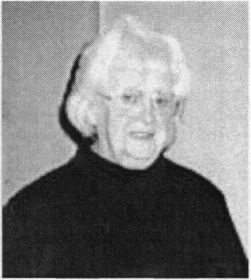
Marjorie McCue Mathieson
In 1960 Marjorie took up painting. It seems Marie was originally the one interested in painting and when she attended classes Marjorie just went along to keep her company. Marjorie has been painting ever since. She has also done leatherwork.
Marjorie tells us the best thing about her life has been her friendships, ‘taking people in and helping them along the way’.
The things she has been proudest of are her swimming ability, knitting and singing - her vocal range was three octaves plus. She is a great raconteur and many stories about the early days of the Robertson family come from her.
John Collins McCUE (1917-1999)
Second child and only son of the Jack McCue and Edith Collins, born at Castlemaine on 28 May 1917. Like his father, John was often called Jack but to save confusion I have stuck to John or John Collins McCue.
John attended school in Castlemaine and the Primary and High Schools in Coburg, Melbourne. After leaving school he undertook a course at Bradshaw’s Business College in South Melbourne, then worked for three years as a salesman in the carpet section of Foy and Gibson’s department store. 29 From his World War II Airforce record we discover that at the age of twenty-four he was 5 feet 11 inches tall, weighed 146 pounds, and had brown eyes and fair hair. 30 At the time he joined up he was working for George Croft at Nullawarre North and his occupation is recorded as ‘farmer - sheep and cattle’. 31 The records contain a ‘Certificate of Exemption from Service’ dated 31 July 1941, presumably because farming was seen as a protected occupation, however John went ahead and joined the RAAF reserve in December, applying to join air crew. His active service began in May 1942. He was initially assigned as a gunner (‘Air crew - Guard’) but eleven months later in April 1943, he was re-mustered as ‘equipment assistant’. His sister Marjorie explained that he was taken off aircrew because he had trouble with a dislocated thumb, which prevented him from pushing the trigger on a gun. Later the thumb was repaired in an operation.
It seems that as a young man John had a bit of a rebellious streak. In February 1943, while serving at the RAAF station at Parkes, John was confined to barracks after responding to a Corporal who told him to leave the kitchen, “I will as soon as I have finished making this piece of toast”. Defaulting on this punishment over the next two days he got a further seven days confined to barracks. Two months later when his fiance’s father was killed in a truck accident Jack went AWOL so he could be with her and was given 168 hours detention. 32
John served in New Guinea from July 1943 until October 1944. He told his son Jeff that while he was in charge of stores in Port Moresby, the Americans came and they had ‘everything’. So John and his mates would slip out at night and pinch their tucker, ‘so we lived pretty well’.
John met Janet STEVENS (1919- ) at a Christian Endeavour meeting in Port Campbell. The courtship involved John riding his bicycle back and forth the 15 miles (24 km) between where Janet lived, and his sister Marjorie’s house at Nullawarre. The couple were married on 28 May 1943, at the Port Campbell Baptist Church by Jack McCue, John’s father. This was shortly before John was sent to New Guinea. While in New Guinea John wrote poetry, which he sent to Janet. John and Janet have three children, Alden (1944), Jeff (1946) and Helen (1951).
page 147
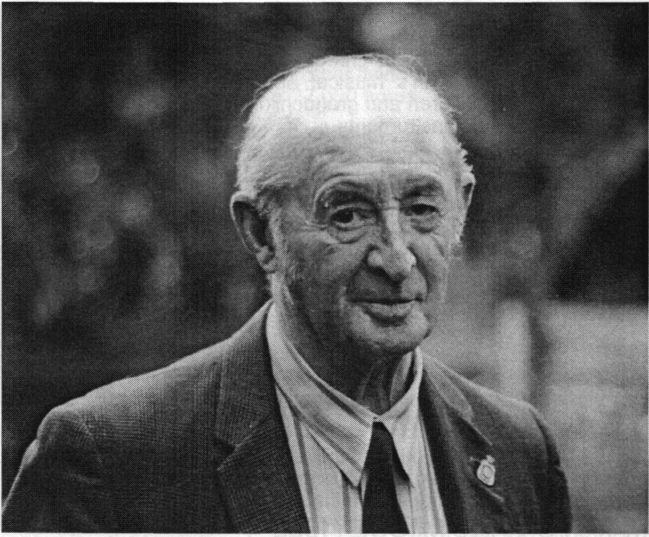
John Collins McCue
After being repatriated from the Airforce in 1945, John and Janet pioneered the cottage system for the Tally-Ho Boys Home at ‘Woodlands’ in Lilydale.
In his request for repatriation John states:
“The Home-Farm consists of a combined orchard and Poultry Farm, where youths from fourteen to sixteen years are trained, not only in farm work, but in the elements of good citizenship through a Christian home atmosphere for a foundation in character, that will make them realize their place in, and responsibility to the community.” 33
After leaving Woodlands, John and Janet bought a soldier settlement farm near Port Campbell and the couple lived there until their retirement. “They moved in with 15 pounds in the bank and food in the pantry and commenced clearing, fencing and dam building. There was no electricity, and transport was by horse and cart.” 34
The tribute presented at John’s funeral describes John as a caring person, a ‘greenie’, and someone with a special interest in ordinary people. Daughter Helen tells us he had a mischievous sense of humour. He was interested in sport - swimming, running and tennis. John was a Heytesbury Shire Councillor for twenty-six years (1964-1990), serving as President of the Shire in 1967-68. It was at his suggestion that new roads in the southern part of the shire were given aboriginal names. 35 This reflects his interest in local history, which was complimented by an abiding interest in family history. Information he collected about the family is included in this Robertson family story. John was a Justice of the Peace, a school counsellor and a teacher of religious instruction. In 1966 he stood as a Country Party candidate for the Polwarth electorate but was defeated.
None of what John did would have been possible without the support of Janet, his hard working wife. Son Jeff left school at fourteen and went to work on the farm and according to Jeff his father sometimes gave his wife and family a bit of a hard time. Occasionally John would disappear, leaving Jeff and his mother to milk anything up to eighty cows on their own. Jeff never knew where he went until years later he met a man who had known his father in Warmambool. It seems John used to go there to play the big pipe organ in the Presbyterian Church. He was noticeable because he was one of the few people who could play it. 36
John was a gifted musician. His ability to play almost anything by ear led some people to believe he could not read music. His mother told granddaughter Helen that when he was learning the piano as a child John would “put a comic book on the piano in front of his lesson books instead of practicing.” Helen writes, “when my brothers were old enough to drive, Dad would sit in the back seat of the car on a long trip and play his ukulele and we’d sing all the way to our destination and back”.37 John played for church services and social functions for over forty years. He had a natural ability to harmonize and he would sing duets with Arthur Ward at the Port Campbell
page 148
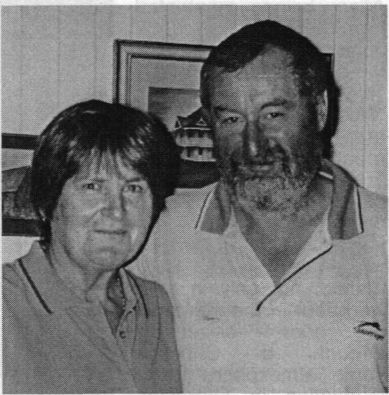
Di and Jeff McCue, 2003
and Waarre Baptist Churches. His ability to play by ear was apparently an asset during his time in the Airforce when he played at church parades and on other occasions. John’s musical ability has been passed on to his children and grandchildren who sing and play a variety of instruments.
John and Janet spent their later years living at their daughter’s property near Melbourne until ill health caused John’s admission to the Rosden Nursing Home in Burwood, Victoria. He died there on 4 December 1999. Janet resides at the Salford Park Retirement Village, Wantirna, Victoria.
Marion Corfield McCUE (1922) - married name PARKER
Youngest child and second daughter of Jack McCue and Edith Collins born at Castlemaine, Victoria on 1 January 1922. 38
When Marion was four months old, Jack was called to the Baptist Church at West Moreland in Melbourne and the family moved there. Marion’s primary education was obtained at several schools including West Coburg Primary and North West Brunswick. In 1932 the family shifted to West Preston and remained there for six years. Marion attended the West Preston Primary School for two years then moved on for four years at the Preston Girl’s Secondary School. When Jack returned to work with the Victorian Temperance Alliance, the family moved into a house in Balwyn Rd, Balwyn.
Marion undertook a course at Business College and at the age of sixteen commenced work with Maurice Blackburn and Co, Barristers and Solicitors in Bourke St Melbourne. Mr Blackburn was a member of the Victorian House of Assembly and Speaker of the House. Later he was elected to the Federal Parliament. He was a member of the Labor Party and the company’s clients included several Trade Unions. Marion writes: “This was a great learning time for me. I spent a good deal of my time out of the Office in my responsibilities as a Law Clerk, attending Courts, Inquests, Probate, Titles Office, Summon Serving etc. Melbourne was full of Service Personal of many Nations, some of them getting on the wrong side of the Law making a busy time for our Office.” 39 One of Marion’s tasks while working as a Law Clerk involved the preparation of probate and the transfer of her Uncle Arthur McCue’s property after his death in 1938. Marion worked for Blackburn and Co until 1945. Between 1945 and 1951 she worked with her father at the Temperance Alliance.
Marion met William Brian PARKER (1922-2001) through mutual friends and in March 1950 she and Bill were married at the Canterbury Baptist Church. Marion’s father officiated at the service. Bill was the son of Frank and Hilda Parker and was born at Shenstone in England. Frank was a farmer and after the family migrated to Australia in 1923, he took up a Soldier Settlement block in the Mallee. The farm was not a success because of poor soil and the family moved to another farm at Drouin where they grew potatoes. When the Depression came the family “had to walk off their land and leave it behind lock, stock and barrel.” 40 Moving to Melbourne, Frank found employment with a transport company and stayed with this firm for the rest of his working life.
page 149
During World War II, Bill Parker served for five years as a pilot with RAAF in Africa, Europe and Asia. Returning to civilian life he tried his hand at truck driving, photography and orchard work until he was accepted by Australian National Airways (later Ansett) as a pilot in 1948. He remained with Ansett for thirty-one years. In addition to his other flying experience Bill amassed 21,500 flying hours with Ansett, making a total of well over 22,000 hours.
After their marriage Marion and Bill lived for a time with her parents while, with the help of family and friends, they built their first home at Eltham Rd, Lower Plenty. It was while they were living here that their three children were born, Michael (1955), and twins Marcia and John (1959). In 1971 the family moved to a new house in McLaughlin’s Lane, Plenty. This time they employed a builder.
In his father's eulogy John Parker describes the family’s life: “Our grandparents were regularly visitors and we played with our aunts and cousins. Summer was always fun and dad had built a wooden rowboat, which had an outboard motor and my family, grandparents and cousins used to play and fish in this boat in the 60’s and 70’s at Frankston and Dromana. He also built model planes and made billy carts and toys for us as children.”
After Bill retired from Ansett, Marion and Bill travelled in Australia and overseas, and served for short terms with the Missionary Aviation Fellowship in Arnhem Land, the Northern Territory and Papua New Guinea.
Both Marion and Bill have been active in their church and local communities. Marion served for twenty-five years as a volunteer with the Greensborough Citizen’s Advice Bureau and the Mornington Information Centre. Bill delivered Meals on Wheels and taught Religious Education in Primary Schools. In 1988 Marion and Bill moved to Somerville on the Mornington Peninsula. Here they attended the Mornington Baptist Church and were again involved in local activities.
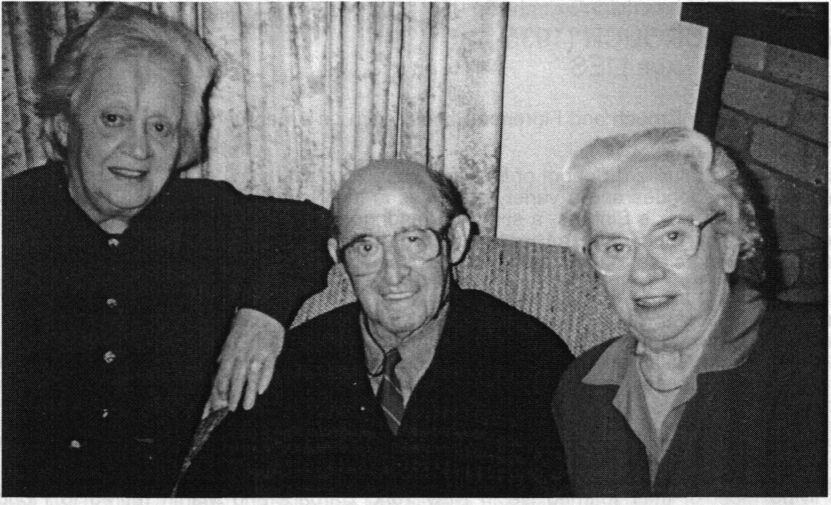
Three McCues
Left to right: Marjorie Mathieson, John McCue, Marion Parker, May 1997.
Bill died in January 2001 and his ashes are interred in the McCue grave at Port Campbell. Marion now lives in Baronia.
page 150
Generation E
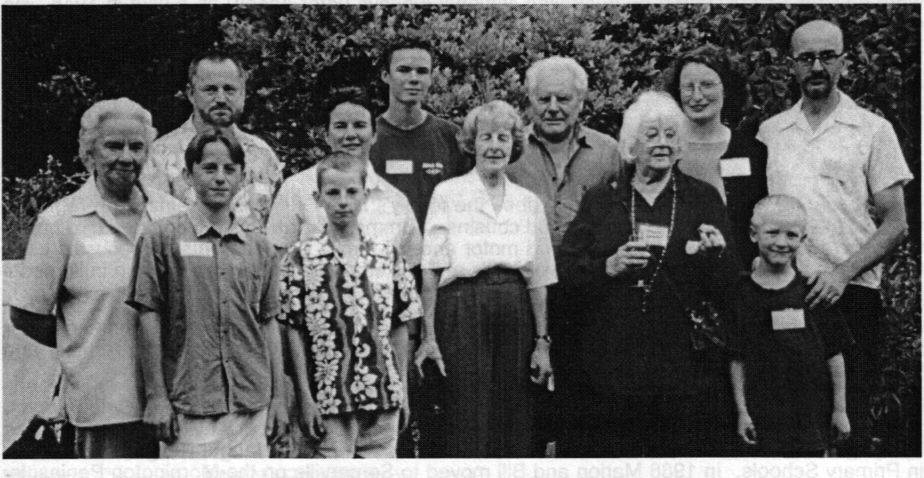
Descendants of Agnes Robertson, Melbourne 2000
Left to right: Marion Parker, Adam & Peter Booth, Justin, Marcia and Christopher Booth, lone Jones, Stuart Le Couteur, Marjorie Mathieson, Zaita Oldfield, Oscar Oldfield-Mathieson, Ross Mathieson.
Barbara Ruth CROUCH (1935-) - married name LIES
Only child of Arthur Crouch and Florence Schulz, born on 4 February 1935, at Eldon, Missouri, USA. 41
Barbara trained at Juilliard School of Music in New York and worked as a professional singer, in churches, synagogues and a variety of places in the New York area. She toured for some years with the Riverside Singers, a six voice madrigal group, and had several seasons at the Milwaukee Melody Top Summer Theatre. After her marriage she started on a twenty-six year career in Real Estate but also continued with her singing.
Barbara married Martin LIES (1934-) in June 1970. 42 The couple met while working with the Riverside Singers. As well a being a singer himself, Martin was a singing teacher, working with opera and Broadway singers and at the Mannes School of Music, the Manhattan School of Music and Vassar College. Barbara and Martin had no children together but Barbara took on the role of stepmother to Martin’s two children from a previous union - Karl Timothy Lies and Deborah Elizabeth Lies Pierson - and they are now proud grandparents.
Barbara has visited relations in Australia on several occasions and during one of these visits she gave a concert at Sea Lake for her grandmother.
After living most of their married life in New York, Barbara and Martin retired to Florida in 1996. Martin sings in the Westminster Presbyterian Church at Daytona Beach and still has a small number of students. Barbara is active in the church and writes a column for the local newspaper.
page 151
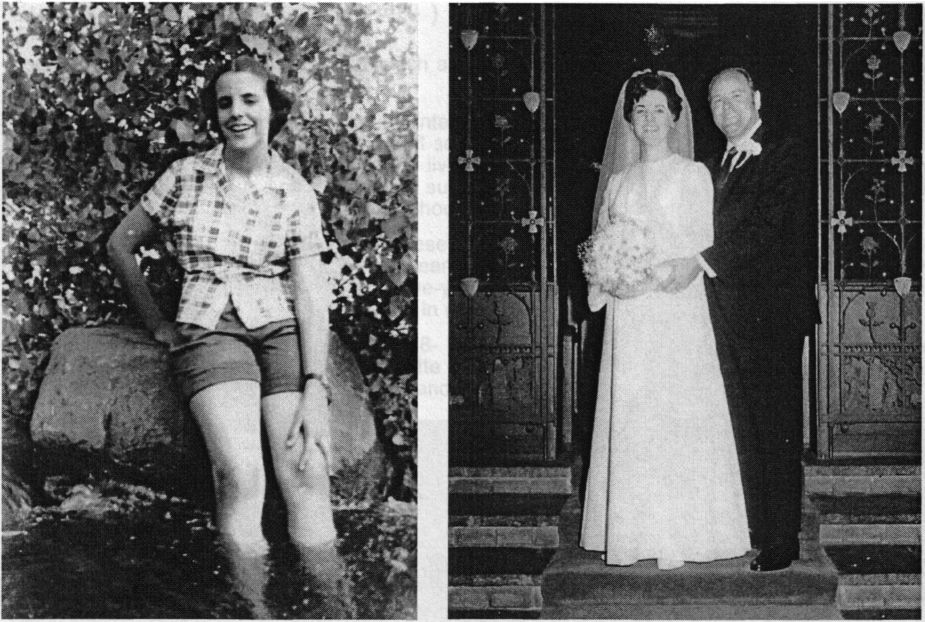
Barbara Ruth Crouch ... Barbara Crouch and Martin Lies, on their wedding day, 3 June 1970.
Alan John RIBBONS (1927-)
Youngest child and only son of Ellie Crouch and Jack Ribbons, born at Merrinee, southwest of Mildura, on 26 November 1927.
Alan was great friends with his cousin Donald Crouch who was a few years younger than Alan. They were both fond of horses and it seems the pair used to get into mischief together. Barbara Rogers tells us of an occasion when they were teenagers. They dressed up with sheets, over their heads and went out onto the road and did their best to frighten passing motorists. 43
After leaving school Alan worked in Robinson’s general store at Turriff for eleven years. His family was living in Turriff at the time. The store sold everything - petrol, oil, kerosene, groceries, ladies wear, shoes, slippers, stockings, dresses, lollies, ice creams, drinks, and anything you might want. Fuel and other goods were delivered to the farms in a big truck. Alan had Wednesday off, but worked on Saturday till 9pm. His cousin Ruth Grace also worked at the Turriff store.
Alan tells the following story about working at the store. When he came home after being away, the boss liked to have a ‘nip’. “These two blokes who had been working at the wheat silo came in for a drink. We had lemonade and raspberry and all the drinks lined in rows in the fridge, so if you went there and you knew what people wanted you could just grab it. These two decided they would have 6 o’clock [a type of soft drink] so I grabbed the 6 o’clock and poured them out their drinks, and they had a glass each. One says ‘I’m feeling thirsty, could you go another one, my shout’. And the other one says ‘yes I’ll go another one’. These two had gone, and paid of course, when the boss arrived home. He says, ‘Has anyone seen my bottle of beer? It was in the row with the 6 o’clock but I took the label off. Who drank it?’ ‘Oh no’ I said, ‘the Methodist minister and the local preacher!’ ‘Oh no!’ says the boss ‘don’t you dare tell anybody’.” 44
page 152
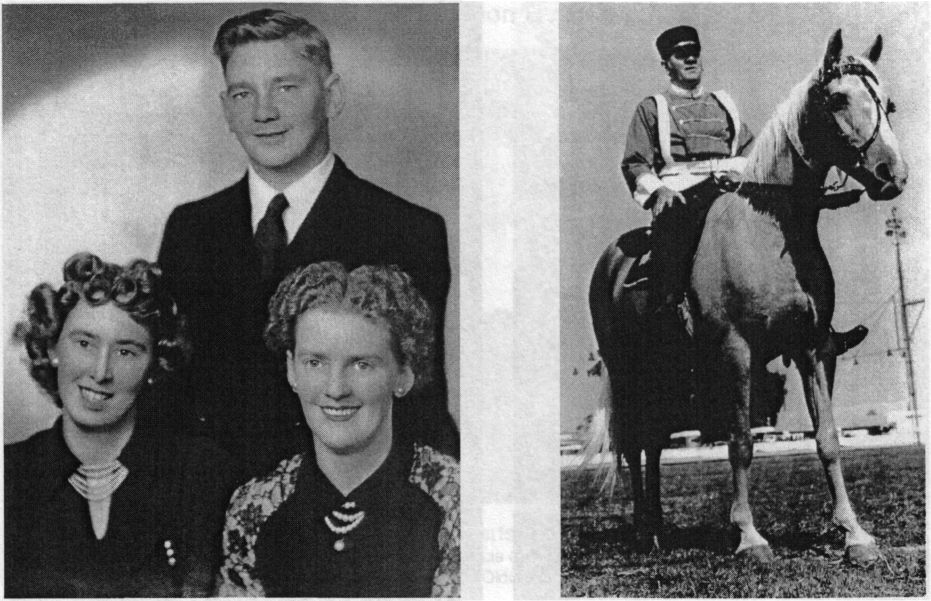
Ribbons Family Left to right: Betty, Alan, Nancy. ... Alan Ribbons on one of his Palomino horses at the Shepparton Show.
Leaving Turriff, Alan worked in a grocery shop in Sea Lake. He then went to Melbourne where he worked for the retail stores Buckley and Nunn as well as Foy and Gibson’s. In the 1950s Alan worked in the S E Dickins store in Glenferrie Rd. Hawthorn and would speak to Mrs Dickins (Lottie Robertson) on the phone when she rang through her grocery order, and arrange for it to be delivered. Alan did not realize at the time that Lottie was one of his relations.
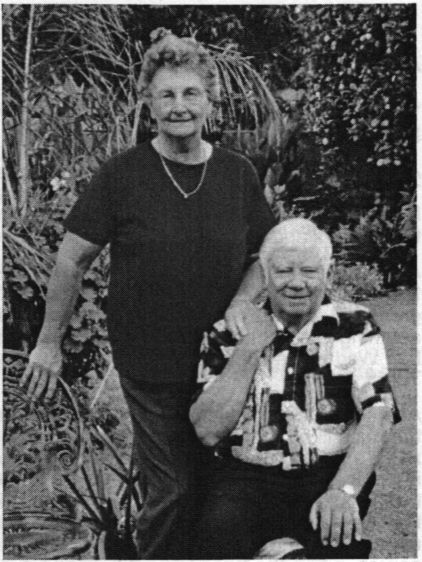
Alan and Betsy Ribbons
Shepparton, April 2000.
While working for Dalgety, Alan was sent to Nathalia. There, through the tennis club, he met Betsy May BURGESS (1926- ). They were married at Shepparton, Victoria on 7 June 1969.
Betsy was the daughter of a farming family at Bunbartha and prior to her marriage she worked in a women’s frock shop. Together Alan and Betsy set up a menswear store in Shepparton and ran this for some years. After selling the shop, they bought a small farm near Shepparton and Alan bred Palomino horses. Alan continues to breed and train horses, specializing in those used in horse drawn vehicles. He sometimes drives these vehicles for weddings and other events. Alan’s has numerous show trophies for his horses and Betsy has trophies as a tennis player.
Another sideline for Alan is training dogs and he and Jolly the dog often performed at charity functions. Both Alan and Betsy enjoy performing and are involved in local concerts and festivities. Alan plays the organ at his church. Beside the front door of their house in Shepparton is a sign announcing This is an alcohol free zone’, the result of Alan’s childhood experiences with a drunken paternal grandfather.
page 153
Clive Robertson CROUCH (1940-)
Second child and only son of Willie Crouch and Bessie Le Couteur, born at Hopetoun, Victoria on 22 November 1940.
From an early age Clive had an abiding interest in natural history and dreamed of becoming a biologist. However at fourteen, Clive left school and began an apprenticeship in joinery and cabinet making, at Kaniva where his family lived. He had been working at this trade for thirteen years when the local high school principal suggested he apply for a teaching position. He did this and was appointed to the Nhill High School to teach woodwork and graphic communication.
In 1964 Clive started studying the Silky Desert Mouse, a small native rodent found in the Little Desert near Kaniva. Hearing about his research, the Professor of Zoology at Monash University contacted Clive. This resulted in a twelve-year association with the Zoology Department at Monash, which allowed Clive to participate in various research projects.
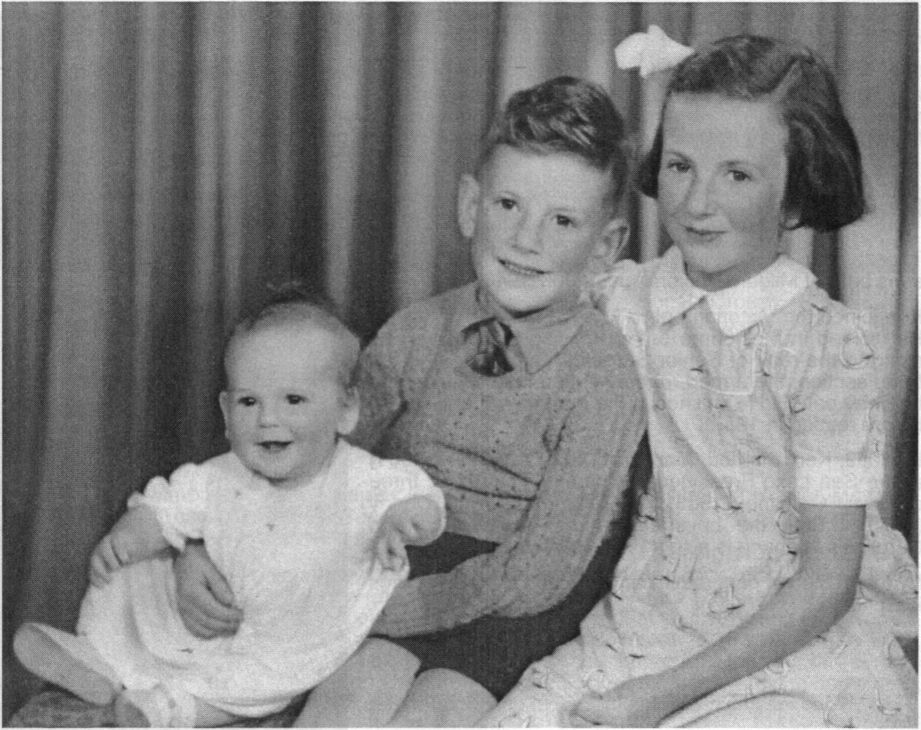
Lorraine, Clive and Beth Crouch, circa 1946
In Nhill, Clive met Janette ARNOLD (1948- ) who was the manager of the fashion section in a local department store. Clive and Janette were married in January 1972. They have three children, Damien (1973), Benjamin (1976) and Meagan (1977).
In 1976 the family moved to Melbourne so Clive could attend the Hawthorn Institute of Education, and after two years study he graduated with a Trained Trade Instructor’s Certificate, a dual qualification which entitled him to teach in both Technical and High Schools. At the graduation ceremony Clive had the job of responding on behalf of the students. Returning to Nhill, Clive again taught at the High School. He served on the Lowan Shire Council for three years (now part of the Hindmarsh Shire).
Clive realized that if he wanted to gain promotion he needed a university degree. He enrolled at the University of New England as an external student and as he had always wanted to study biology he majored in Biology and Geography, with sub-majors in Environmental Studies and
page 154
Prehistoric Archaeology (Aboriginal pre-history). After graduating he was promoted to a Senior Teacher position and two years later to Deputy Principal, before opting for ‘promotion in the classroom’. Clive writes, “I got sick of working 70-80 hours a week and having no time for my family, or to pursue my hobbies and interests, but it was a great experience and I gained a lot from having filled that position. Having such a diverse background and such diverse training I am now able to teach Science, Biology, Geography, Environmental Studies, Woodwork, Metalwork Graphic Communication and Technology. It really suits me to teach a variety of subjects and to teach at all levels in the school. After 34 years I still enjoy teaching, but I suppose one day I will have to think about retiring.” 45
For some years Jan worked as a hatchery attendant at Luv-a-Duck [Clive tells me it is the biggest duck processing business in the southern hemisphere]. She resigned from this job when she was diagnosed with breast cancer needing radical surgery and chemotherapy treatment. Fortunately the treatment was successful and Janette is working again on a part time basis at a local motel.
Clive did retire from teaching and this gives him more time to indulge his interest in natural history, native fauna and the environment. He has served on various committees including the National Parks Advisory Committee, the Board of Greening Australia, as secretary of the local committee of Management of Trust for Nature, and as secretary of the West Wimmera Tree Group Inc. He has been responsible for obtaining grants of over $300,000 for projects sponsored by the groups he has worked with.
Clive writes, “Although my father often lamented the fact that he was not able to do much for me, because of his injuries and poor health (and lack of money being an invalid pensioner), he nevertheless instilled in me a lot of important qualities, such as giving back to the community, having concern for others and to make the most of every opportunity.” 46
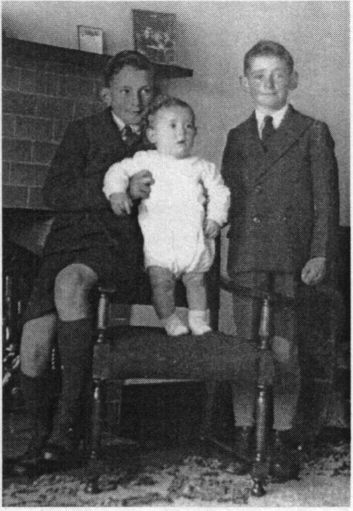
Lindley, Richard and Kenneth Crouch, circa 1948
Kenneth Frederick CROUCH (1940-)
The second of Eddie Crouch and Adah Finger’s three sons born at Mildura, Victoria on 19 July 1940.
Ken joined the Victorian police force at the age of twenty. He worked in Melbourne before moving to Bendigo and rising to the rank of Senior Sergeant. He worked in the fraud section, the armed robbery squad, surveillance and highway patrol. He finished in the drug squad at Bendigo before retiring in 1997.
In 1962 Ken married Margaret McLEAN (1942-2001) at the Sea Lake Presbyterian Church. They have three children, Caroline (1963), Andrew (1965) and Danny (1970).
Margaret died of pancreatic cancer in 2001. Ken still lives in Bendigo.
page 155
Donald Morris CROUCH (1932-1977)
Only child of Norman Crouch and Myrtle Selby, born at Werrimull on 2 December 1932. 47
Don shared a love of horses with his cousin Alan Ribbons and the two were friends. There is a photo of them both on horses taken in the 1930s. The pony Donald is riding was breed by Arthur McCue at Port Campbell.
Don worked as a dam sinker, still using a team of horses in the 1950s. Later he was a baker at Speed. Moving with his mother to Irymple after his father’s death in 1968, Don trained and raced trotters and was successful with a horse called Yankee Look.
Believing he had a brain tumour, Don shot himself in 1977. He was unmarried and had no issue.
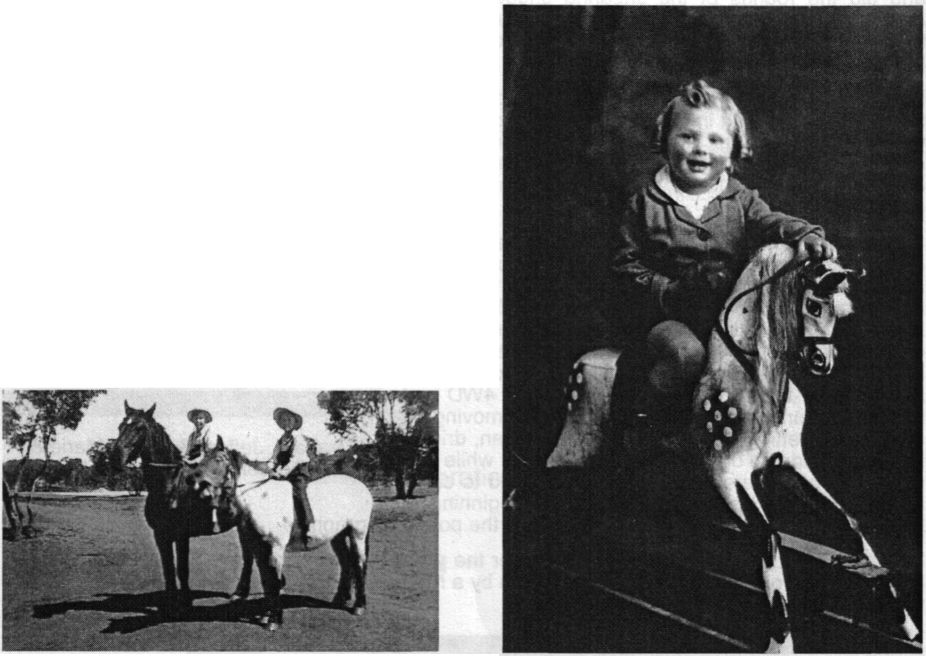
Alan Ribbons and Donald Crouch on horses bred by Arthur McCue at Port Campbell. ... Donald Crouch
David John MOTT (1939-)
David and his twin brother Jeffrey James were the second eldest children of Russell Mott and Vivienne Howe. They were born at Sea Lake on 4 November 1939.
As young as six and seven Russell and Vivienne’s boys started helping on the family farm at Gama East. The three eldest boys drove the bulldog tractor as a joint effort, one of them steering, another working the pedals, and the third changing the gears. By the time they were eight and nine they were taking truckloads of wheat into the depot at Gama, driving in unison as they did with the tractor. It took all three of them to lift a bag of wheat. One time as they were driving along the door of the truck fell off. The boys deposited the door at the side of the road and on the way home they picked it up and threw it in the back of the truck. Arriving home their father’s comment was ‘I’d better put the door back, one of you little blokes might fall out.’ 48
David was always in trouble at school and often played truant. At first he and his brothers drove the three miles to school in the family gig, but one day the horse bolted and the gig was overturned and smashed. After that the children walked to school. On the way they would do the rounds of the rabbit traps and as a result they were nearly always late for school. David did not get on with the minister who conducted the religious instruction classes. The minister had a wobbly eye and one day he caught David mimicking him. David was stood in the corner. David left school the day he turned fourteen.
page 156
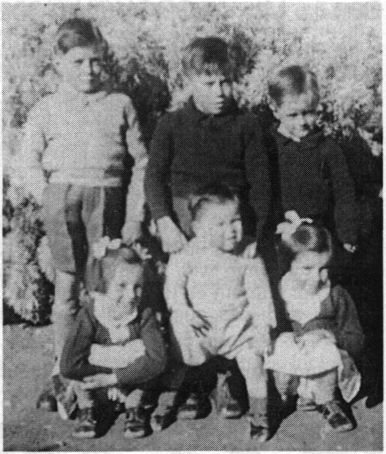
Graham, Jeffrey & David, Marie and Doreen and Bruce Mott
After leaving school David worked on the family farm and did the rounds of the shearing sheds. David, Jeffrey and Graham formed a partnership and bought their own farm, which they ran for twenty-one years as Mott Brothers.
David met Alice Joy LEECH (1946-) at a dance and the two were married in December 1963. Joy’s father was a scrap merchant, which David’s dad thought was a very useful occupation. David and Joy have three daughters, Debbie (1965), Kerrie (1966) and Narelle (1971).
In 1978 the Mott Brothers broke up their partnership, each taking three blocks of their joint property. In about 1980 David invented and patented a ‘knock on blade’ for a blade plough. Ten years later David sold his farm and went to Queensland where he bought a grazing property and leased a service station at Yuleba near Roma. After two years David and Joy decided to move on, so they bought a caravan and a 4WD and travelled around Australia. David has been moving on ever since, getting work as and where he can driving heavy equipment or caretaking properties while the managers or owners take leave. I managed to catch up with him in Western Australia at the beginning of 2003, just in time to get his story included in the potted biographies.
David admits to being accident-prone. Over the years he has had snake bite, road accidents, lost the top off one of his fingers, been bitten by a red back spider and most recently an accident with a horse which damaged his shoulder.
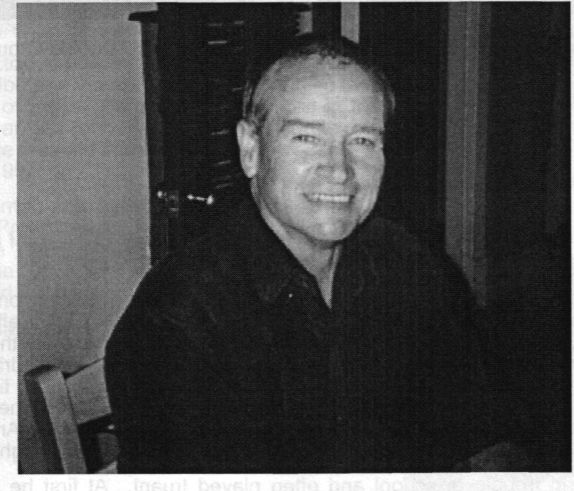
David Mott, Perth January 2003
1 Taped interview with Alan Ribbons, April 2000
2 Letter from Alan Ribbons, March 2001
3 I taped Alan reciting this poem during the April 2000 visit
4 Bessie Crouch wrote about her life and this material was supplied to me by her son Clive
5 Information about Arthur and Florence provided by their daughter, Barbara Lies
6 The equivalent of the Church of Christ in Australia is known as the Christian Church in the USA. Barbara Lies suggested I use Church of Christ in the text, to save confusion for Australian readers.
7 Email from Barbara Lies, 16.11.2000
8 Letter from Alan Ribbons, August 2000
9 Interview with Alan Ribbons, April 2000
10 Letter from Betty Powell, March 2001
11 Ibid
12 Bessie Crouch writing about her life
13 Taped interview with A Ribbons, April 2000
14 See Appendix 3
15 Bessie Crouch
16 Interview with Clive Crouch, April 2000
17 Information about Eddie and his family was provided by Ken Crouch in an interview April 2000 and letters. The quotes are taken from Ken’s letters.
18 Ada spelt her name Adah, until she discovered it had no h' on her birth certificate.
19 Bessie’s notes supplied by Clive Crouch
20 Interview Barbara Rogers, Portland, April 2000
21 Interview with A. Ribbons, April 2000
22 Interview with K. Crouch, April 2000
23 These stories come from a joint interview with Heather Richards, Dot Geary and Margaret Powell, April 2000
24 Interview with David Mott, 13.1 2003
25 Letter from Sue Boyd, 16.7.2000
26 Information about Russell obtained during an interview with Debbie Riley, 3.1.2003
27 Information about Marjorie’s life comes from letters, telephone conversations and an interview in March 2000
28 See Appendix 2 for notes on the relationship between McCue and Le Couteur families
29 Information about John and Janet McCue comes from his children Jeff McCue and Helen Krigsman, John's two sisters, his RAAF service record and the tribute presented by the Rev Frank Wakeling at John’s funeral.
30 John McCue’s Service record, a copy of which is in my possession
31 The Crofts are related to the Robertsons through both the Mathieson family and through the marriage of Margaret Robertson Chiselett’s daughters.
32 RAAF records
33 RAAF records
34 Funeral tribute
35 J. Fletcher, And We Who Followed - a History of the Fleytesbury Shire 1921- 1987’, p.271. There are a number of references to John McCue’s Council work in Fletcher's book.
36 Interview with Jeff McCue, April 2000
37 Letter from Helen Krigsman, 9.2.2001
38 The following information compiled from correspondence and telephone conversations with Marion Parker and the Eulogy presented at Bill Parker’s funeral in January 2001.
39 Marion Parker, 18.6. 2001
40 Bill Parker’s Eulogy, written by John Parker
41 Information about Barbara and Martin Lies provided by Barbara in letters, September-November 2000
42 The name Lies is of German origin and is pronounced Lease’
43 Interview with Barbara Rogers, April 2000
44 Interview with Alan Ribbons, April 2000
45 Letter from Clive Crouch, 26.3.2001
46 Ibid
47 Information about Donald comes from Alan Ribbons
48 Interview with David Mott, 13.1 2003
Garry Gillard | New: 25 March, 2019 | Now: 22 October, 2022